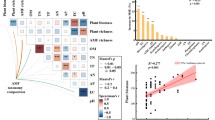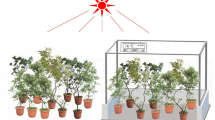Summary
At a site in the Sonoran Desert, subterranean rocks and exposed boulders affected soil water potential as well as root morphology and distribution. For Agave deserti, the number of lateral roots per unit length of main root was 11 times higher under rocks and six times higher alongside rocks than in rock-free regions. Total root length per unit soil volume for Echinocereus engelmannii averaged 3-fold higher within 1 cm of boulders than 5 cm away, where the soil was drier. The total length of lateral roots per unit length of main root for Ferocactus acanthodes was 4.2 m m−1 under rocks but only 0.8 m m−1 in rock-free regions. The number of lateral roots per unit length of main root for Opuntia acanthocarpa was 7-fold higher alongside rocks than in rock-free regions and even higher under rocks. For transplanted and watered A. deserti, the number of new main roots produced per 1–2 month interval averaged 13 for five plants on the north side of boulders, 8 on the south side, 11 for five plants with half of their roots under rocks, 2 for those with half of their roots over rocks, and 3 for the control plants without rocks. Laboratory experiments showed that the soil water potential under rocks for 10 and 30 mm waterings stayed above −0.5 MPa for 13 and 19 d longer, respectively, than for regions away from rocks. The shortwave absorptance of granitic rocks from the field site was 0.82, the thermal conductivity coefficient was 1.50 W m−1 °C−1, and the volumetric heat capacity was 1.75 MJ m−3 °C−1. Field measurements indicated that 5-cm-thick buried rocks decreased the diel variation in soil temperatures on their undersurface by only 0.4° C compared with soil. Thus, the primary influence of rocks at the field site on root proliferation and branching for the four species was apparently caused by influences on soil water content.
Similar content being viewed by others
References
Agassi M, Levy GJ (1991) Stone-cover and rain intensity: Effects on infiltration, erosion and water splash. Aust J Soil Res 29:565–575
Berman B (1976) Thermal Conduction in Solids. Oxford University Press, Oxford
Cannon WA (1911) The Root Habits of Desert Plants. Carnegie Institution of Washington, Washington, DC
Carslaw HS, Jaeger JC (1959) Conduction of Heat in Solids, 2nd edn. Oxford University Press, Oxford
Cass A, Campbell GS, Jones LT (1984) Enhancement of thermal water vapor diffusion in soil. Soil Sci Soc Amer J 48:25–32
Cloudsey-Thompson JL (1956) The effect of rock cover on the diurnal range of microclimatic conditions. Entomologist 89:213–215
Dean WRJ, Turner JS (1991) Ants nesting under stones in the semi-arid Karoo, South Africa: predator avoidance or temperature benefits? J Arid Environ 21:59–69
Drew MC (1979) Root development and activities. In: Goodall DW, Perry RA, Howes KMW (eds) Arid-land Ecosystems: Structure, Functioning and Management Vol 1. Cambridge University Press, Cambridge, pp 573–606
Dunkle RW, Edwards DK, Gier JT, Bevans JT (1960) Solar reflectance integrating sphere. Solar Energy 4:27–39
Epstein E, Grant WJ, Struchtemeyer RA (1966) Effects of stones on runoff, erosion, and soil moisture. Soil Sci Soc Amer Proc 30:638–640
Evenari M, Shanon L, Tadmor N (1971) The Negev: The Challenge of a Desert. Harvard University Press, Cambridge, Massachusetts
Hellmers H, Horton JS, Juhren G, O'Keefe J (1955) Root systems of some chaparral plants in southern California. Ecology 36:667–678
Huey RB, Peterson CR, Arnold SJ, Porter WP (1989) Hot rocks and not-so-hot rocks: Retreat-site selection by garter snakes and its thermal consequences. Ecology 70:931–944
Jury WA, Bellantuoni B (1976a) Heat and water movement under surface rocks in a field soil: I. Thermal effects. Soil Sci Soc Am J 40:505–509
Jury WA, Bellantuoni B (1976b) Heat and water movement under surface rocks in a field soil: II. Moisture effects. Soil Sci Soc Am J 40:509–513
Lamb J Jr, Chapman JE (1943) Effect of surface stones on erosion, evaporation, soil temperature, and soil moisture. J Am Soc Agron 35:567–578
Larmuth J (1978) Temperatures beneath stones used as daytime retreats by desert animals. J Arid Environ 1:35–40
Lide DR ed (1990) CRC Handbook of Chemistry and Physics, 71st Edn. CRC Press, Boca Raton, Florida
Nobel PS (1976) Water relations and photosynthesis of a desert CAM plant, Aqave deserti. Plant Physiol 58:576–582
Nobel PS (1977) Water relations and photosynthesis of a barrel cactus, Ferocactus acanthodes, in the Colorado Desert. Oecologia 27:117–133
Nobel PS (1978) Microhabitat, water relations, and photosynthesis of a desert fern, Notholaena parryi. Oecologia 31:293–309
Nobel PS (1988) Environmental Biology of Agaves and Cacti. Cambridge University Press, New York
Nobel PS (1991) Physicochemical and Environmental Plant Physiology. Academic Press, San Diego, California
Nobel PS (1992) Root-soil responses to water pulses in dry environments. In: Caldwell MM, Pearcy RW (eds) Exploitation of Environmental Heterogeneity by Plants: Ecophysiological Processes above and below Ground. Academic Press, San Diego, California (in press)
Nobel PS, Cui M (1992) Hydraulic conductance of the soil, root-soil air gap, and root: changes for desert succulents in drying soil. J Exp Bot 43:319–326
Nobel PS, Geller GN (1987) Temperature modelling of wet and dry desert soils. J Ecol 75:247–258
Nobel PS, Hartsock TL (1986) Environmental influences on the productivity of three desert succulents in the southwestern United States. Plant Cell Environ 9:741–749
Nobel PS, Lee CH (1991) Variations in root water potentials: Influence of environmental factors for two succulent species. Ann Bot 67:549–554
Nobel PS, Loik ME, Meyer RW (1991) Microhabitat and diel tissue acidity changes for two sympatric cactus species differing in growth habit. J Ecol 79:167–182
Smith WK, Nobel PS (1977) Temperature and water relations for sun and shade leaves of a desert broadleaf, Hyptis emoryi. J Exp Bot 28:169–183
Stark N (1970) Water balance of some warm desert plants in a wet year. J Hydrol 10:113–126
Takahashi H, Scott TK (1991) Hydrotropism and its interaction with gravitotropism in maize roots. Plant Physiol 96:558–564
Young DR, Nobel PS (1986) Predictions of soil-water potentials in the north-western Sonoran Desert. J Ecol 74:143–154
Author information
Authors and Affiliations
Rights and permissions
About this article
Cite this article
Nobel, P.S., Miller, P.M. & Graham, E.A. Influence of rocks on soil temperature, soil water potential, and rooting patterns for desert succulents. Oecologia 92, 90–96 (1992). https://doi.org/10.1007/BF00317267
Received:
Accepted:
Issue Date:
DOI: https://doi.org/10.1007/BF00317267




